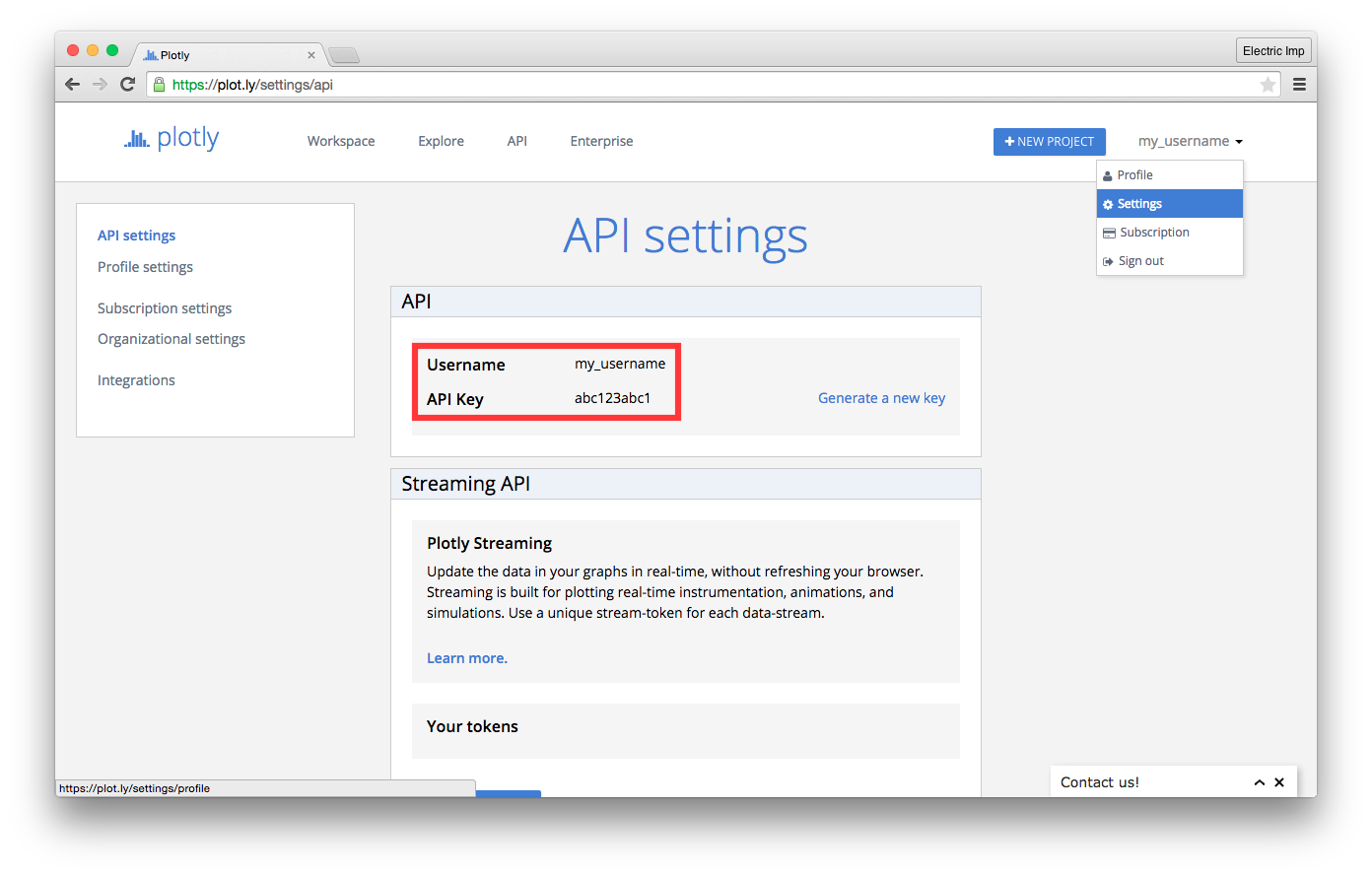This library wraps the Plotly [REST API] (https://plot.ly/rest/), allowing you to graph and style data obtained from Imp-connected sensors.
This class allows for simple creation of time-series data graphs while exposing access for styling graphs using all features of the Plotly API. Note that this library requires creation of a Plotly account.
To add this library to your project, add #require "Plotly.class.nut:1.0.1" to the top of your agent code.
To see working examples of this library in use, look at the Fully-Featured and Minimal Plotly projects.
Almost all methods in this class (including the constructor) take an optional callback argument. This is a function that takes arguments error, response, and decoded, where error is a string (or null if no error occured), response is a table representing a response from the Plotly servers and decoded is a table representing the JSON object returned by the Plotly servers. The response object mirrors that provided in the callback to httprequest.sendasync(). Make sure to check the error argument before using either response or decoded.
Note that while the constructor will return immediately, it is only safe to operate on the resulting object once the callback has been called. It is the user's responsibility to ensure at this step that the construction has succeeded by checking the HTTP response code and/or Plotly response messages.
To create a plot, you need to call the constructor with your Plotly authentication information and some basic data about the new graph.
To find your userName and userKey, go to the Plotly API settings page and copy the Username and API key as highlighted below. Note that the userKey is not your password, but is an API key that Plotly provides for developers. Whenever you cycle your API key (e.g. by clicking "Generate a new key"), you will have to update this value in your code as well.
Let fileName be the file name you would like this graph to have in your Plotly account.
Let worldReadable be true if you would like this graph to be accessible to anyone with a link to the plot. If this is false, the graph will only be accessible to your account by viewing the plots you own.
Let traces be a list of the data point names you would like to graph. Each Plotly graph can display many concurrent values known as traces, but you must list them all here before plotting them.
#require "Plotly.class.nut:1.0.1"
local callback = function(error, response, decoded){
if (error) {
server.log("Got an error: " + error);
return;
}
server.log("See plot at " + myPlot.getUrl());
}
myPlot <- Plotly("<YOUR_USERNAME>", "<YOUR_API_KEY>", "weather_data", true, ["temperature", "inside_humidity", "outside_humidity"], callback);Returns a string with the URL of the graph that this object generates. Note that if worldReadable was set to false in the constructor, this link will only be viewable when logged into Plotly.
local plotUrl = myPlot.getUrl();Sets the title that will be displayed on this graph.
myPlot.setTitle("Weather at Station 7");Sets the labels that will be applied to the standard x- and y-axes on this graph. If either argument is null or empty, that axis title will not be changed.
myPlot.setAxisTitles("Time", "Temperature (°F)");Adds a second y-axis on the right side of the graph and assigns the specified traces to it. traces should be a list of the string names of traces as passed in the traces argument to the constructor.
myPlot.addSecondYAxis("Humidity (%)", ["inside_humidity", "outside_humidity"]);Sets the style of the graph by passing a description directly to the Plotly API. This allows for advanced styling options that this library does not have specific methods for.
styleTable should be a Squirrel list or table that will be parsed into JSON. See the [Plotly API docs] (https://plot.ly/rest/) for details on how to format this argument.
Note that there are several caveats to using this method:
- This will entirely overwrite style parameters previously set using methods like
AddSecondAxisorsetStyleDirectly. - If there is an error in formatting styleTable, an error may be passed to callback or the call may silently fail.
local style =
[
{
"name" : "temperature",
"type": "scatter",
"marker": {"symbol": "square", "color": "purple"}
},
{
"name" : "inside_humidity",
"type": "scatter",
"marker": {"symbol": "circle", "color": "red"}
}
];
myPlot.setStyleDirectly(style);Sets the layout of the graph by passing a description directly to the Plotly API. This allows for advanced layout options that this library does not have specific methods for.
layoutTable should be a Squirrel list or table that will be parsed into JSON. See the [Plotly API docs] (https://plot.ly/rest/) for details on how to format this argument.
Note that there are several caveats to using this method:
- This will entirely overwrite layout parameters previously set using methods like
AddSecondAxis,setTitle, orsetLayoutDirectly. - If there is an error in formatting layoutTable, an error may be passed to callback or the call may silently fail.
Appends data to the Plotly graph. This method takes an array dataObjs of Squirrel tables in the following form:
{
"name" : <TRACE_NAME>,
"x" : [<X_VALUE_1, X_VALUE_2, ...>],
"y" : [<Y_VALUE_1, Y_VALUE_2, ...>]
"z" : [<OPTIONAL_Z_VALUE_1>, <OPTIONAL_Z_VALUE_2>, ...]
}Note that the "x", "y", and "z" fields hold arrays of integers or strings and the "z" field is optional.
Each element in dataObjs must have a name field that corresponds to a trace name as passed into the constructor. To add multiple data points to a trace, either add them to the traces data arrays or make multiple calls to this method.
myPlot.post([
{
"name" : "temperature",
"x" : [timestamp],
"y" : [latest_temperature]
},
{
"name" : "inside_humidity",
"x" : [timestamp],
"y" : [latest_humidity]
}
]);Returns a timestamp string that Plotly will automatically recognize and style correctly. Use this for your x-value on time-series data.
If the timestamp argument is provided as a Unix timestamp, this function will output the formatted timestamp corresponding to it.
local timestamp = Plotly.getPlotlyTimestamp();
myPlot.post(
{
"name" : "temperature",
"x" : [timestamp],
"y" : [latest_temperature]
});The Plotly library is licensed under the MIT License.
